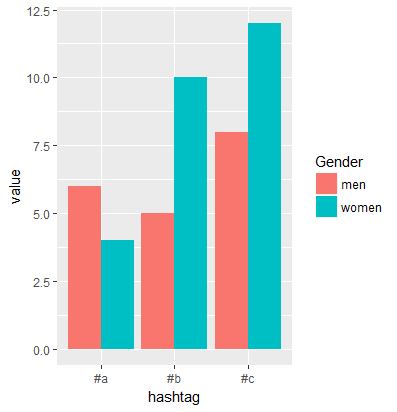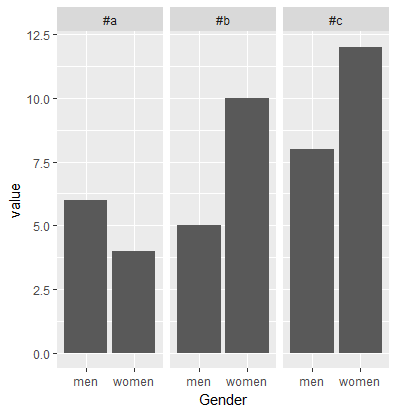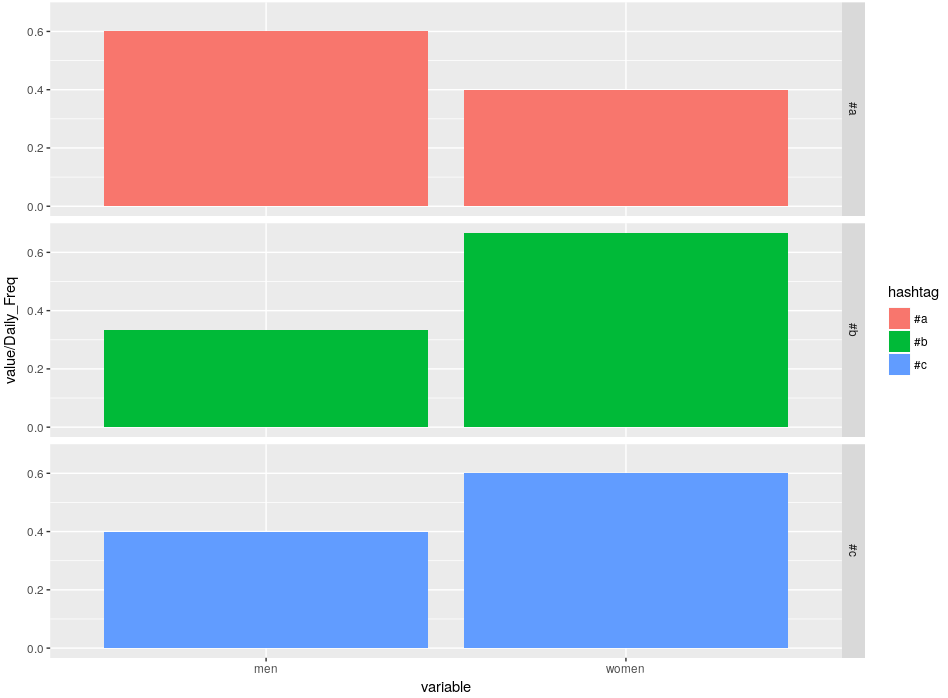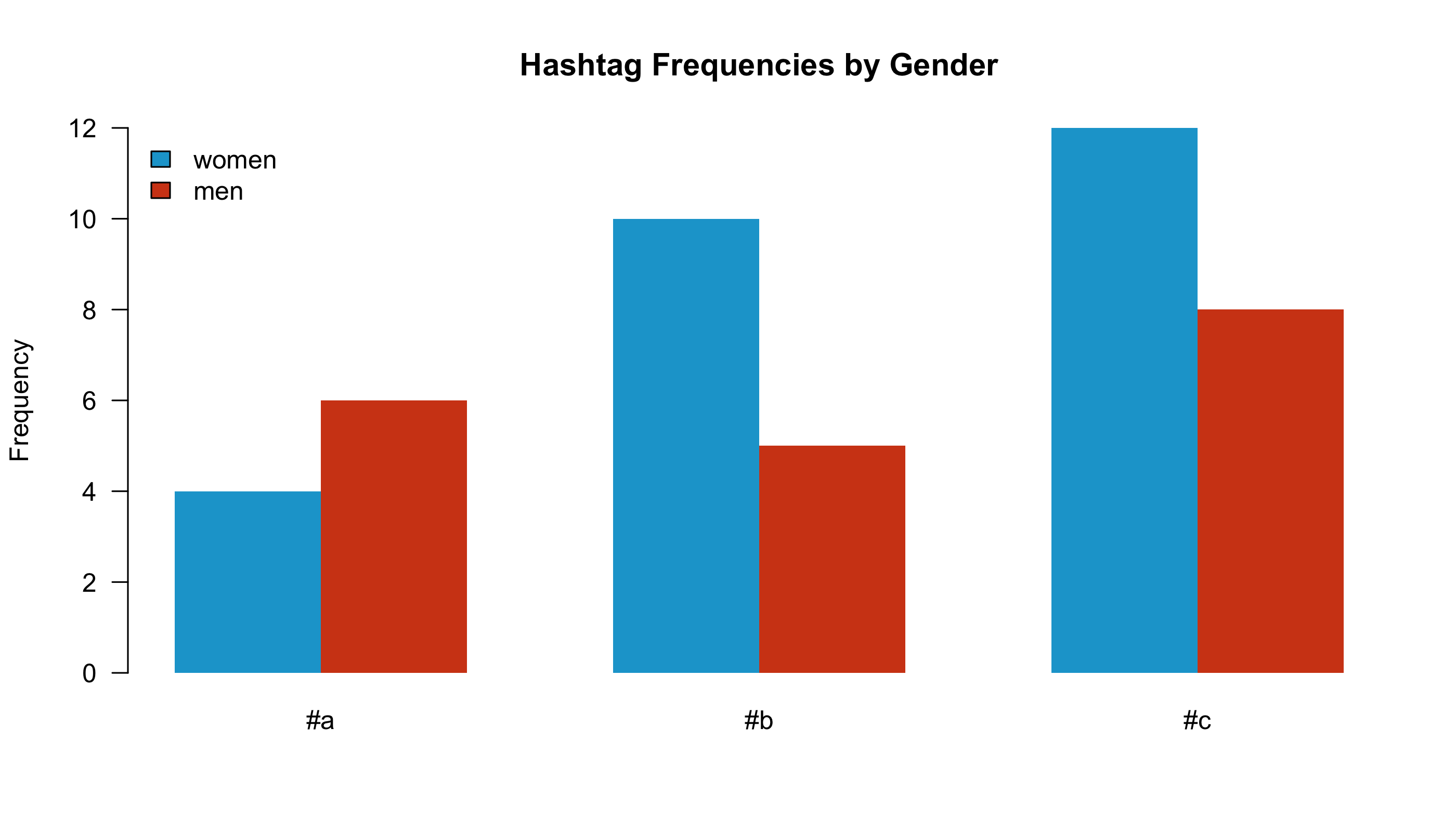在R中逐行绘制数据帧
在R中逐行绘制数据帧
提问于 2018-03-03 13:55:45
我有张像这样的桌子
hashtag Daily_Freq men women
#a 10 6 4
#b 15 5 10
#c 20 8 12 我想为每个数据帧行,即每个标签,男性和女性的频率绘制图表。在这种情况下,我想要绘制3个酒吧,每一个有两列-一个为男性,一个为女性频率。我该怎么做?
回答 3
Stack Overflow用户
回答已采纳
发布于 2018-03-03 14:11:35
一种解决方案是将gather和ggplot2用作:
#data
df <- read.table(text = "hashtag Daily_Freq men women
'#a' 10 6 4
'#b' 15 5 10
'#c' 20 8 12", header = T, stringsAsFactors = F)
library(tidyverse)
df <- df %>% select(-Daily_Freq) %>%
gather(key = Gender, value, -hashtag)
library(ggplot2)
ggplot(df, aes(x=hashtag, y=value, fill=Gender)) +
geom_bar(stat='identity', position='dodge')

选项2
ggplot(df, aes(x=Gender, y=value)) +
geom_bar(stat='identity', position='dodge') + facet_grid(~ hashtag)

Stack Overflow用户
发布于 2018-03-03 15:15:58
利用来自melt的reshape2的解决方案如下:
library(ggplot2)
library(reshape2)
df <- read.table(text = "hashtag Daily_Freq men women
'#a' 10 6 4
'#b' 15 5 10
'#c' 20 8 12",
header = TRUE)
ds <- melt(df, id.var = c("hashtag", "Daily_Freq"))
p <- ggplot(ds, aes(x=variable, y=value/Daily_Freq))
p <- p + geom_bar(stat='identity',
position='dodge',
aes(fill=hashtag))
p <- p + scale_colour_discrete()
p <- p + facet_grid(hashtag ~. )
show(p)作为产出,

Stack Overflow用户
发布于 2018-03-03 18:13:35
在使用barplot()之前创建一个命名矩阵
使用apply(),您的表可以转换为一个2x3矩阵,每个性别1行,以及每个唯一的hashtag值一列。
然后,将新创建的矩阵提供到height参数中的barplot()中。

# load data
df <-
read.table(
text = "hashtag Daily_Freq men women
'#a' 10 6 4
'#b' 15 5 10
'#c' 20 8 12"
, header = TRUE
, stringsAsFactors = FALSE
)
# we want three barcharts
# one for unique hashtag
# and each with two columns
# one for men and one for women
gendered.frequencies.by.hashtag <-
apply( X = df
, MARGIN = 1
, FUN = function( i )
as.numeric(
c( i[["women"]], i[["men"]] )
)
)
# name the rows
rownames( x = gendered.frequencies.by.hashtag ) <-
c( "women", "men" )
# name the columns
colnames( x = gendered.frequencies.by.hashtag ) <-
unique( df$hashtag )
# create complementary color scheme
color.scheme <- c( "#18A4D2", "#D24618" )
# plot the matrix
png(
filename = "Gendered_Freq_by_HT.png"
, res = 300
, units = "px"
, height = 1600
, width = 2800
)
barplot(
height = gendered.frequencies.by.hashtag
, names.arg = colnames( gendered.frequencies.by.hashtag )
, legend.text = TRUE
, args.legend = list(
x = "topleft"
, bty = "n"
)
, col = color.scheme
, border = NA
, beside = TRUE
, las = 1
, ylim = c( 0, max( gendered.frequencies.by.hashtag ) )
, main = "Hashtag Frequencies by Gender"
, ylab = "Frequency"
)
# shut down plot device
dev.off()
# end of script #页面原文内容由Stack Overflow提供。腾讯云小微IT领域专用引擎提供翻译支持
原文链接:
https://stackoverflow.com/questions/49084901
复制相关文章
相似问题

